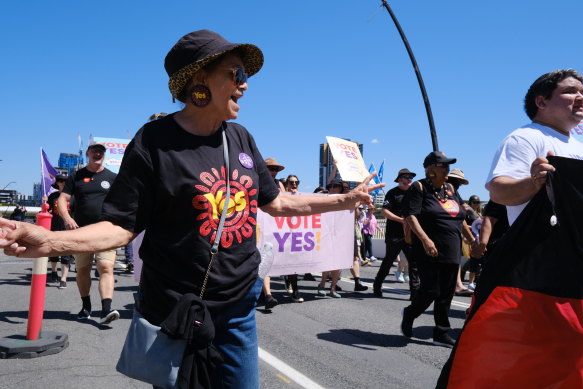This was published 1 year ago
‘Voting with us, not for us’: Thousands of Voice supporters march in Brisbane
By Matt Dennien
The news
Thousands of people have marched through Brisbane to support a Yes vote in the Voice referendum, as campaigners urged attendees to escalate their efforts to convince others to do the same.
The event was one of several in major cities nationwide this weekend that drew tens of thousands of supporters to the streets to mark the final push towards the October 14 vote.
In Brisbane, crowds including First Nation and political leaders gathered at South Bank before walking across Victoria Bridge to Queens Gardens for speeches from elders and music from performers including Xavier Rudd and Bernard Fanning.
Queensland Treaty Minister and Quandamooka woman Leeanne Enoch told the Brisbane crowd the nation faced a “profound turning point”.
“So I ask all of you to continue the work that you’ve been doing: marching, talking, calling people, having the conversations so we see a yes vote ... on the 14th of October,” she said.
Why it matters
The referendum will ask Australian voters if they agree to alter the Constitution to establish an Aboriginal and Torres Strait Islander Voice to advise federal parliament and government on matters relating to First Nations peoples.
Polling, while limited, suggests most First Nations people support the Voice, though some – from both sides of politics – question if an advisory body is the best way to address structural disadvantage, inequalities and injustice.
Polls measuring support among the broader population show stronger support for the No vote, with many still undecided, amid a bruising campaign in which key No figures have sought to paint the Voice as racially divisive or lacking in detail.
What they said
Yes campaign spokesperson Thomas Mayo told the Queens Gardens crowd “a great majority” of Indigenous Australians support the Voice.
“When you vote yes, you are voting with us, not for us,” he said.
Other speakers included federal Greens Brisbane MP Stephen Bates, while Logan-based treasurer Jim Chalmers and several members of the state Labor government – including Premier Annastacia Palaszczuk – were among the marchers.

Yes vote supporters march through Brisbane on Sunday. Organisers estimated 20,000 people marched; police put the number at 5000.Credit: Matt Dennien
Uncle Joe Kirk, a Turrbal elder and one of several Queensland First Nations leaders to address the crowd at both South Bank and the CBD, said Prime Minister Anthony Albanese recently said he wanted more involvement from the community.
“Well, who better to talk to [than] our elders,” he said to cheers.
What to look out for
The latest people can ensure they are enrolled to vote is 8pm on Monday, September 18, with early voting to open in Queensland on October 3. Postal vote applications close on October 11.
Both a national majority of voters and a majority in at least four of the six states are needed for the referendum to succeed.
What you need to know
Discussion about recognising First Nations peoples in the Australian Constitution have been underway for more than a decade under federal governments led by both major parties.
In 2017, after lengthy Indigenous-led nationwide talks about such options, 250 First Nations delegates gathered and agreed on the Uluru Statement from the Heart.
No is continuing the status quo which is failing ... whereas Yes is trying something different. Yes is simply listening to Indigenous people.
Yes spokesperson Thomas Mayo
The statement called for a Voice to parliament, followed by a Makarrata Commission to oversee agreement-making with governments and then truth-telling about Indigenous history.
Finer details of the Voice advisory body will be decided by the government in consultation with Indigenous communities if the referendum succeeds, but its members will be selected by those communities.
More reading
- 17 things you need to know about the No pamphlet
- The Yes pamphlet annotated: 14 things you should know
Sean Parnell sends an exclusive newsletter to subscribers each week. Sign up to receive his Note from the Editor.